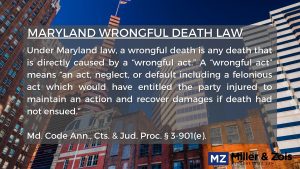The untimely death of a family member or someone you love can be devastating, both emotionally and economically. This type of loss can be even harder to accept when it was caused by someone else’s negligence. Fortunately, our civil legal system gives you the ability to do something about this by filing a wrongful death lawsuit.
The Maryland wrongful death lawyers at Miller & Zois help the survivors hold people accountable for the death of their family member and get financial compensation for their loss. Wrongful death lawsuits are often misunderstood, and our office gets a lot of questions about this topic. In this post, we will go over three key facts that you need to know about Maryland wrongful death lawsuits.
Definition of “Wrongful Death” Under Maryland Law
The starting point for understanding wrongful lawsuits is understanding the legal definition of a “wrongful death” in Maryland. Under Maryland law, wrongful death is any death directly caused by a “wrongful act.” A “wrongful act” means “an act, neglect, or default including a felonious act which would have entitled the party injured to maintain an action and recover damages if death had not ensued.” Md. Code Ann., Cts. & Jud. Proc. § 3-901(e). This basically means that the death is “wrongful” if it was caused by the negligent, intentional, or criminal actions of another person (or company). Actions resulting in wrongful death can include:
- A negligent action (e.g., negligently running a red light)
- A negligent omission (e.g., failing to put a fence around a swimming pool)
- Intentional criminal act (e.g., shooting someone in the head with a gun)
- Reckless criminal acts (e.g., drag racing in a school parking lot while intoxicated)
Negligent actions or omissions can be committed by companies and corporations as well as individual people. For example, if a pharmaceutical company releases a dangerous drug that kills people, the company can be liable for wrongful death.
Who Can be a Plaintiff in a Maryland Wrongful Death Lawsuit?
Only certain close family members of the deceased person have legal standing to bring a wrongful death claim under Maryland law. Close family members with primary standing to bring a Maryland wrongful death claim include a spouse, parent, or child of the deceased person. If there is no spouse, parent, or child of the deceased, a wrongful death claim can be brought by “anyone related by blood or marriage” if they were dependent on the decedent.
Below are some hypothetical examples to illustrate how these standing rules apply in various circumstances:
DECEDENT INFO
WHO HAS WD STANDING?
Wife
Children
Both Parents
Joe is 23 when gets killed in a traffic accident. He has a pregnant wife and both his parents are still living, but his parents are divorced.
Wife
Both Parents
(Divorce doesn’t matter)
Joe is 19 when he dies as a result of medical malpractice. He has a fiancé and no children. His father is deceased, but his mother is still alive.
Mother
Jake is 5 when dies in a car accident. Both his parents are alive, but they were never married. Jake’s biological father has never been in the picture, but after Jake’s death, he wants to be a plaintiff in the wrongful death case.
Mother
(Father precluded unless adjudicated as the father)
Jake is 32 when he dies in a car accident. He has a girlfriend who has lived with him for 5 years and his parents are alive and still married.
Parents
Statute of Limitations in Wrongful Death Cases
Maryland wrongful death cases are subject to a statute of limitations, just like any other tort claim. A statute of limitations is a law that puts a strict time limit on how long you have to file suit after the injury or death occurs. Under Maryland law, wrongful death claims must be filed within 3 years of the decedent’s death. Md. Code. Ann, Cts. & Jud. Proc. § 3-904(g).
This rule can sometimes extend the statute of limitations in wrongful death cases. For example, let’s say an incident of medical malpractice occurs in 2015 and the victim develops HIV as a result. The victim only has 3 years to file a malpractice case under the regular statute of limitations. However, if the victim dies from his HIV 5 years later, his surviving family members will get another 3 years from the date of his death to bring the wrongful death claim based for medical malpractice.
Contact Miller & Zois About Your Wrongful Death Claim
If you lost a family member and think you might be entitled to bring a wrongful death case, call our office at 800-553-8082 or contact us online. We have some of the most successful wrongful death lawyers in Maryland and we can help you understand your options.
 Maryland Injury Law Center
Maryland Injury Law Center


